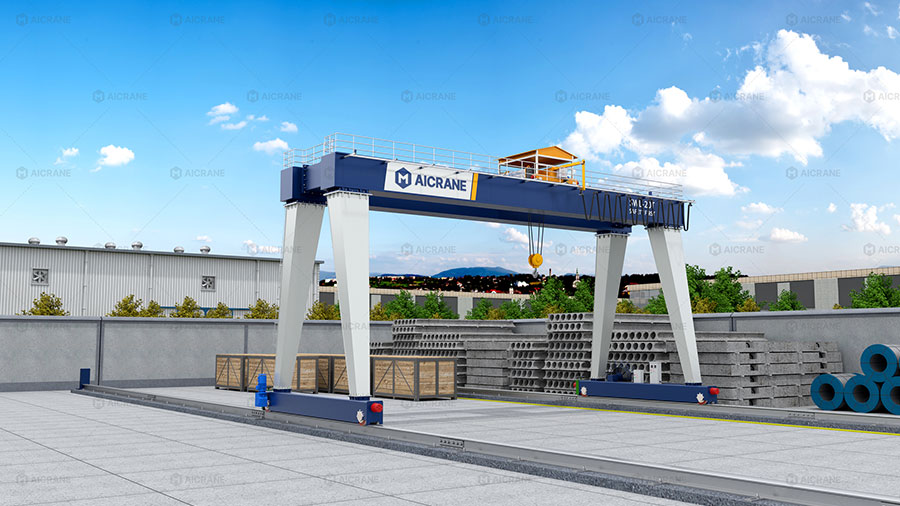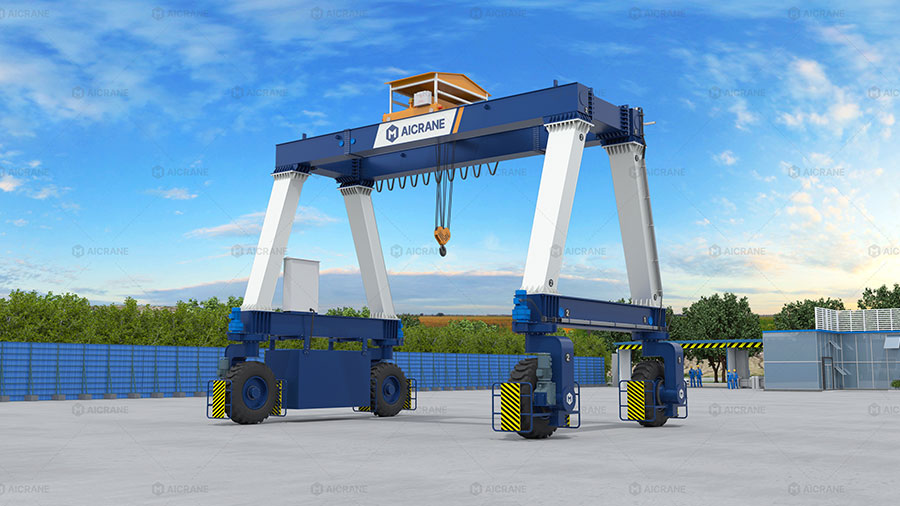In the realm of modern heavy lifting, double girder gantry cranes are indispensable for industries such as shipbuilding, precast concrete production, container terminals, and heavy equipment manufacturing. These robust machines are designed to lift and transport extremely heavy loads with precision and efficiency. However, when lifting large, suspended loads, one of the most significant operational challenges is sway — the pendulum-like motion caused by the load swinging due to acceleration, deceleration, or wind forces. This not only compromises operational safety but also hinders productivity. The introduction of anti-sway technology presents a game-changing solution to this issue.
While the operational benefits of anti-sway technology are well recognized, its structural implications are equally critical to understand. Integrating anti-sway systems into double girder gantry cranes significantly influences their structural design, load dynamics, component stress distribution, and overall integrity. This article explores in depth the structural impact of incorporating anti-sway technology into double girder gantry cranes.

Understanding Anti-Sway Technology
What is Anti-Sway Technology?
Anti-sway technology is a system implemented to suppress or eliminate the swinging motion of loads during heavy duty gantry crane operation. These systems typically involve advanced control algorithms, sensors, programmable logic controllers (PLCs), and variable frequency drives (VFDs) that coordinate the motion of the crane’s trolley and hoist to counteract any sway generated during movement.
Active vs. Passive Systems
-
Passive Systems use mechanical dampers or pendulum restraining devices to reduce sway, with minimal electronic control.
-
Active Systems rely on real-time input from sensors and dynamically adjust trolley speed or hoist positioning to eliminate sway altogether.
Structural Modifications Required
1. Control System Housing and Integration
The addition of anti-sway systems, especially active types, requires dedicated enclosures and routing spaces for the control hardware. This can result in structural redesigns of the operator cabin, trolley, or girder walkway to accommodate PLC cabinets, wiring ducts, and sensor placement brackets.
-
Impact: Increased weight and changes in center of gravity distribution across the girder and trolley structure.
-
Structural Adjustment: Reinforcement or redesign of housing structures to prevent localized stress points.
2. Enhanced Load Path Design
Anti-sway systems introduce new dynamic response patterns, especially during corrective actions made by the trolley in real-time. These dynamic corrections change the frequency and amplitude of load shifts.
-
Impact: More frequent but controlled stress impulses transmitted through the girders, legs, and rail tracks.
-
Structural Adjustment: Main girders may require enhanced damping mechanisms or stronger cross-beams to handle new stress patterns.
3. Higher Rigidity in Trolley and Girder Connection
Active anti-sway systems rely on precise trolley movement. Any structural flexing or deformation between trolley and girder could misalign sensor readings and reduce effectiveness.
-
Impact: Reduced structural compliance requirements.
-
Structural Adjustment: Use of higher-grade steel or double web girders to enhance stiffness and minimize vibration.
4. Refined Trolley Rail Design
Since the anti-sway system continuously adjusts the trolley’s position with high precision, any unevenness or deviation in trolley rails can introduce errors.
-
Impact: Structural deflection tolerances become stricter.
-
Structural Adjustment: Tighter rail manufacturing and installation standards, possible use of pre-stressed rail beds or continuous welded rails.

Dynamic Load Considerations
1. Reduced Peak Sway Forces
The primary structural benefit of anti-sway technology is the reduction of peak forces caused by uncontrolled swinging. Traditional gantry crane for sale without sway control often requires over-design to accommodate worst-case pendulum loads.
-
Impact: Lower peak bending moments on girders and supporting legs.
-
Structural Optimization: Designers can reduce safety factors slightly, or redistribute them to focus on fatigue resistance rather than impact loading.
2. New Fatigue Patterns
With continuous correction movements, the structure experiences more frequent but lower-magnitude loading cycles.
-
Impact: Increased fatigue frequency, even if peak loads are lower.
-
Structural Adjustment: Use of fatigue-resistant welds and inspection-access design enhancements to monitor cracks or wear in high-cycle stress areas.
3. Impacts on Braking Systems
Anti-sway systems demand precision stops and starts. This increases the reliance on braking systems, which must be structurally integrated into the gantry’s support and trolley systems.
-
Impact: Increased torsional and compressive loads at the rail interface and brakes.
-
Structural Adjustment: Reinforcement around trolley drive mounts and wheel assemblies.
Safety and Redundancy Requirements
1. Sensor Redundancy and Mounting Stability
Sensors used in anti-sway systems must be rigidly mounted to avoid false readings due to structural vibration.
-
Impact: Additional mounting brackets or sensor frames may be welded or bolted onto the girder or trolley.
-
Structural Adjustment: These supports must be vibration-isolated yet structurally robust.
2. Emergency Bypass Structures
In case the anti-sway system fails, the crane should still operate safely under manual or conventional control.
-
Impact: Structures must support both automated and manual control regimes.
-
Structural Adjustment: Dual-mode safety integration may require additional housing and wiring pathways.
Integration with Crane Legs and Mobility Systems
1. Leg Flexibility vs. Anti-Sway Performance
Rubber-tired or rail mounted gantry cranes with long, flexible legs experience a degree of structural sway themselves. If the legs flex independently of the girder and trolley, sway suppression becomes less accurate.
-
Impact: Need for increased leg rigidity or synchronized sway damping.
-
Structural Adjustment: Cross-bracing, torsion-resisting elements, or use of box-section legs for added stiffness.
2. Track and Wheel Alignment Precision
Because anti-sway technology ensures precise movement, any misalignment in gantry rails can introduce lateral sway or induce feedback errors.
-
Impact: Misalignment amplifies dynamic forces.
-
Structural Adjustment: Precision installation and leveling of gantry tracks, with structural calibration of wheels and end carriages.
Long-Term Structural Benefits
1. Extended Structural Lifespan
By minimizing pendulum forces, anti-sway technology reduces stress peaks and material fatigue, leading to longer service life for structural members.
2. Reduced Need for Structural Over-Design
Traditional gantry cranes are designed with large safety margins to accommodate unpredictable sway forces. Anti-sway systems reduce variability, enabling more efficient use of materials and less conservative design parameters.
3. Lower Maintenance and Repair Frequency
Fewer high-impact events reduce wear on load-bearing components such as joints, welds, and mechanical fasteners, reducing the structural maintenance load over time.
Conclusion
The integration of anti-sway technology into double girder gantry cranes introduces substantial improvements in operational efficiency and safety. Structurally, it brings both challenges and benefits. While the system imposes new design constraints such as increased stiffness, fatigue considerations, and tighter manufacturing tolerances, it also enables more optimized load distribution, reduced peak stress events, and longer service life of crane components.
As industries increasingly demand precision and reliability in lifting operations, the role of anti-sway systems becomes indispensable. Designers and engineers must account for these technologies early in the planning and structural analysis phases to fully leverage their advantages without compromising the crane’s structural integrity. In doing so, they not only build smarter cranes — they also build safer and more enduring lifting infrastructure.